The Douglas A-4 Skyhawk has a long and impressive history that spans over more than half a century. Developed for the US Navy and Marine Corps, it’s been adopted by Air Forces around the world and continues to be a beast in the sky. With numerous variations of the aircraft, there’s an A-4 Skyhawk to suit everyone’s needs. It’s versatility, speed and maneuverability made it a popular aircraft at a very reasonable price.
Ed Heinemann came up with the Douglas A-4 Skyhawk’s first design
In the 1950s, the cost and weight of combat aircraft were continually increasing. At the same time, there was a need for the US military to replace the aging, piston-engine Douglas AD (A-1) Skyraider. Originally, the Douglas Aircraft Company intended to replace it with another piston-engine aircraft, but production on a small, lightweight plane – then known as the A4D-1 Skyhawk – was already underway, and it seemed too good to pass up as a worthy successor.

Ed Heinemann, the chief designer of the A-4 Skyhawk, began designing the aircraft in the early 1950s, and the first iteration saw its first flight in 1956. Heinemann had previously read a study that described how, for every 100 pound weight reduction, the takeoff run would decrease by eight feet, the combat radius would increase by 22 miles and the climb-rate would climb by 18 feet per minute. He applied this knowledge to the A-4, making sure to decrease its weight as much as possible.
Production begins on the new aircraft
Heinemann and his team were able to make the A-4 Skyhawk lightweight, without compromising the features necessary to make it an effective military aircraft. The design came in at half of the maximum weight of the US Navy requirement and did so through a number of new innovations.
The addition of a delta wing not only avoided the requirement that the wings fold, but also shaved off 200 pounds from the total weight. The fuel tank was designed to be more compact, with a fuselage tank of 240 gallons and a wing tank of 520 gallons. These were only two of the many innovations applied to help lighten the A-4 Skyhawk, without compromising its effectiveness.
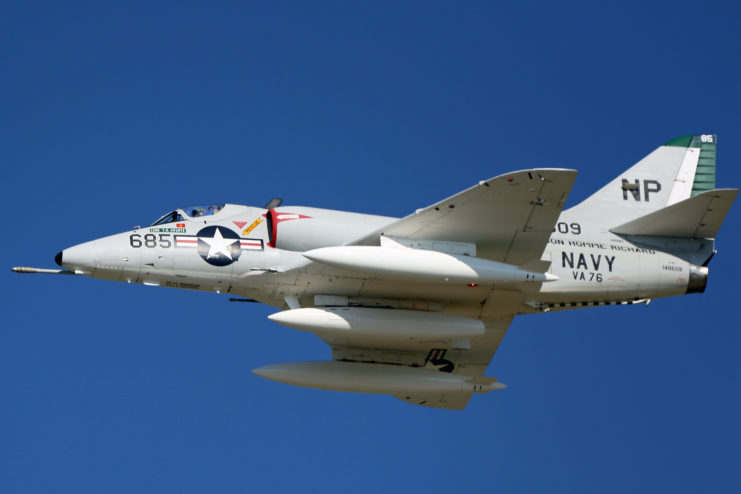
With these adjustments, the A-4 Skyhawk was given the nicknames “Bantam Bomber,” “Scooter,” “Tinker Toy Bomber,” “Heinemann’s Hot-Rod” and “Kiddiecar.” The first 500 were delivered for a price tag of $860,000 per unit – a whopping 14 percent lower than the original target price. Call that a steal!
Skyhawk models, A-4A to A-4C
The A-4 Skyhawk had many variations, each one derived from its predecessor, but with upgraded or slightly-tuned features. One hundred and sixty-five began production and were declared operational in the mid-1950s. The aircraft was promising and only experienced minor issues during testing, all of which were easily fixed, and deliveries began in late-1956.
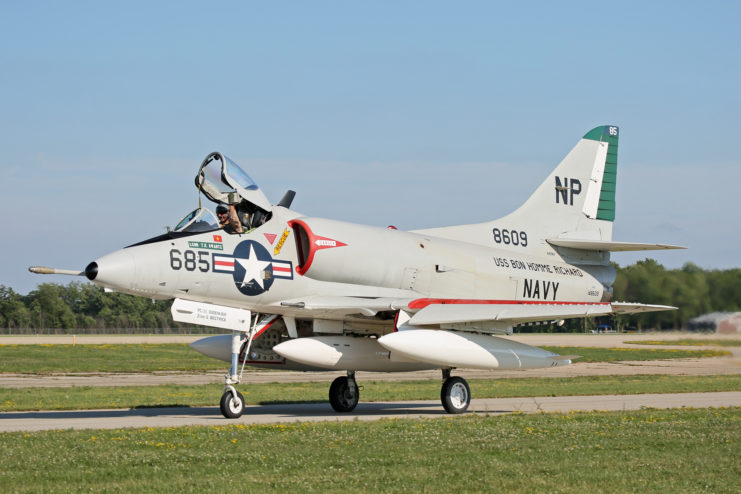
Even with the first A-4 Skyhawks being delivered, the next variation was already being developed. The A-4B boasted many improvements. It had a new engine and hydraulics system, as well as air-to-air refuelling capabilities. This variant proved to be a step up from the previous, and its increased efficiency reflected in its production numbers. Five hundred and forty-two Skyhawk A-4Bs were produced, almost four times more than the original aircraft.
Interest in the A-4 Skyhawk continued to increase; there just seemed to be more and more room for improvement. Development of the A-4C variant quickly began, and deliveries were being made by 1960. The A-4C Skyhawk included avionic changes, a low-altitude bombing system, an all-altitude reference system and an automatic flight control system. As well, the aircraft was now all-weather. The new specs of the A-4C led to it being the most produced variant of all the Skyhawks, with 638 built.
Douglas A-4E Skyhawk
By 1961, A-4 Skyhawk deliveries had reached 1,000 units. Originally designed with the idea of nuclear battles in mind, the first couple of aircraft were intentionally made to house weapons and defenses that would combat nuclear threats. By the beginning of the 1960s, this became less of an immediate problem, and the need arose for aircraft that could house conventional weapons for non-nuclear missions.
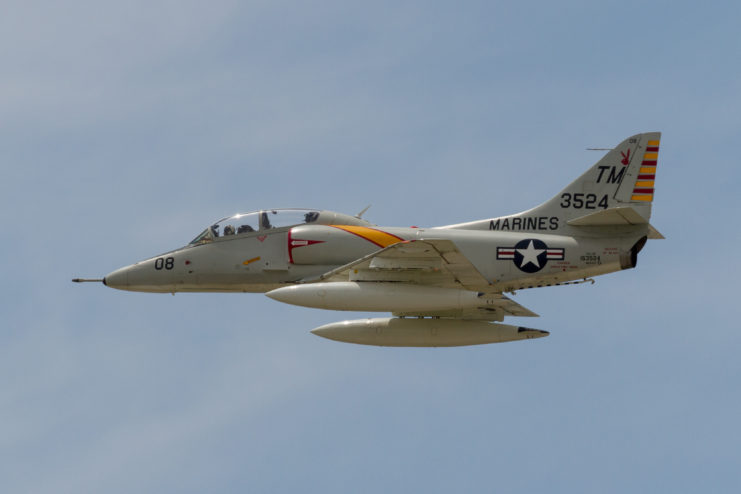
The A-4E Skyhawk was made for that exact purpose. Like the other variants, it was adapted from the basic A-4 design, but could deliver conventional munitions and had room for a two-person crew, instead of a solo pilot. To make this version of the aircraft possible, it was developed with an extra pair of underwing weapons hard-points, located underneath each outer wing, allowing it to carry a wider variety of weapons and fuel options.
The nose of the A-4E Skyhawk was also lengthened by 14 inches, to allow for a navigation computer. The aircraft also saw the addition of Doppler radar, a radio altimeter and improved bombing systems, making it an obvious choice for the Navy to use as an advanced trainer.
In total, just under 500 A-4E Skyhawks were built. By the time the light attack aircraft stopped being produced in 1979, Douglas Aircraft Company has built 2,960 units.
Use of the Douglas A-4 Skyhawk in Vietnam
A-4 Skyhawks were influential aircraft for the American effort during the Vietnam War. Ground forces were in desperate need for close air support, and the A-4 provided that vital aid. Each aircraft was armed with two 20mm cannons and could carry additional weapons in external pods. They also had the smallest possible airframe, which made them extremely easy to transport on aircraft carriers, as well as making them both fast and maneuverable.
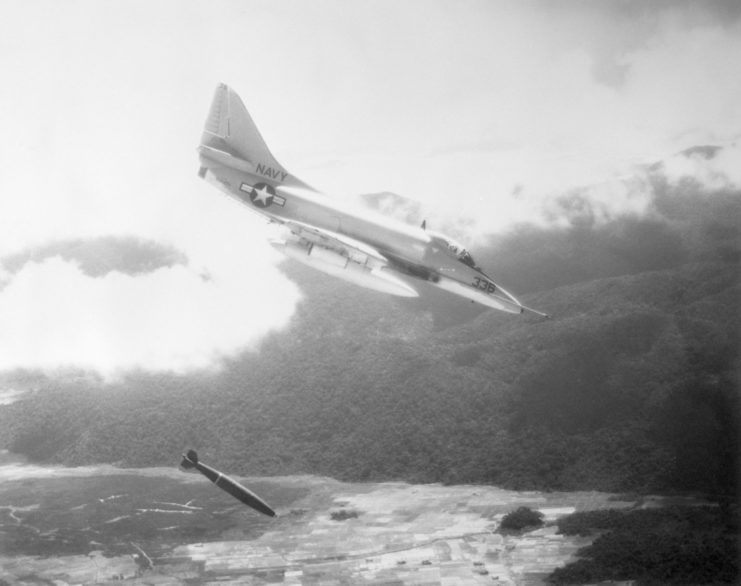
The A-4 had an impressive record during the war, carrying out some of the first US airstrikes and reportedly dropping the last US bombs on Vietnam. It had accuracy in hitting select targets and participated in more combat missions than any other naval aircraft. It fought in both North and South Vietnam, and only 195 carrier-based A-4s fell to the Vietnamese during the conflict.
International use of the Douglas A-4 Skyhawk
The success of the A-4 Skyhawk was seen in conflicts beyond the Vietnam War. Argentina became the first foreign purchaser of the aircraft, and by the outbreak of the Falklands War, the country’s Air Force had purchased 130, refurbished by Lockheed Service Co. Forty-eight Skyhawks were deployed, of which only 19 were lost by the war’s close on June 14, 1982.
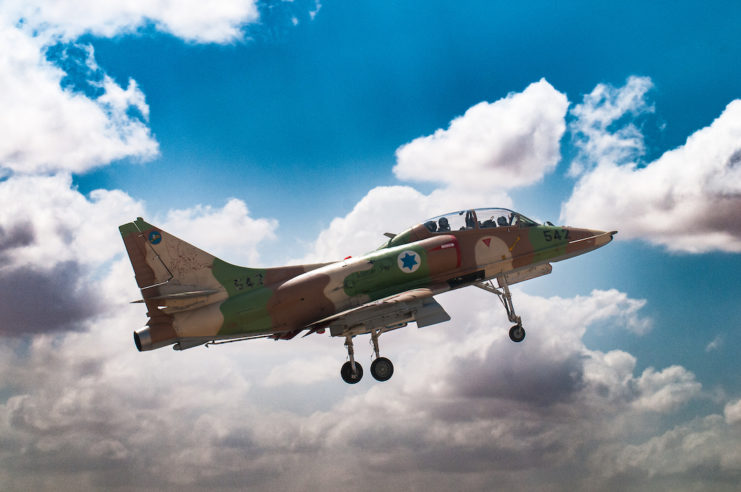
More from us: How the Sophisticated B-2 Spirit Stealth Bomber Stays Invisible
Israel was the largest purchaser and operator of the A-4 Skyhawk outside of the US. The Israel Defence Force and Air Force first requested the aircraft in 1964 and signed a contract with the US that allowed for more detailed inspections of their nuclear research facilities, as well as the promise that the A-4s would not be equipped with nuclear weapons, in exchange for more of the planes.
By 1976, it’s believed Israel had acquired 321 new and used A-4 Skyhawks. By the 1990s, that number had risen to around 355.
